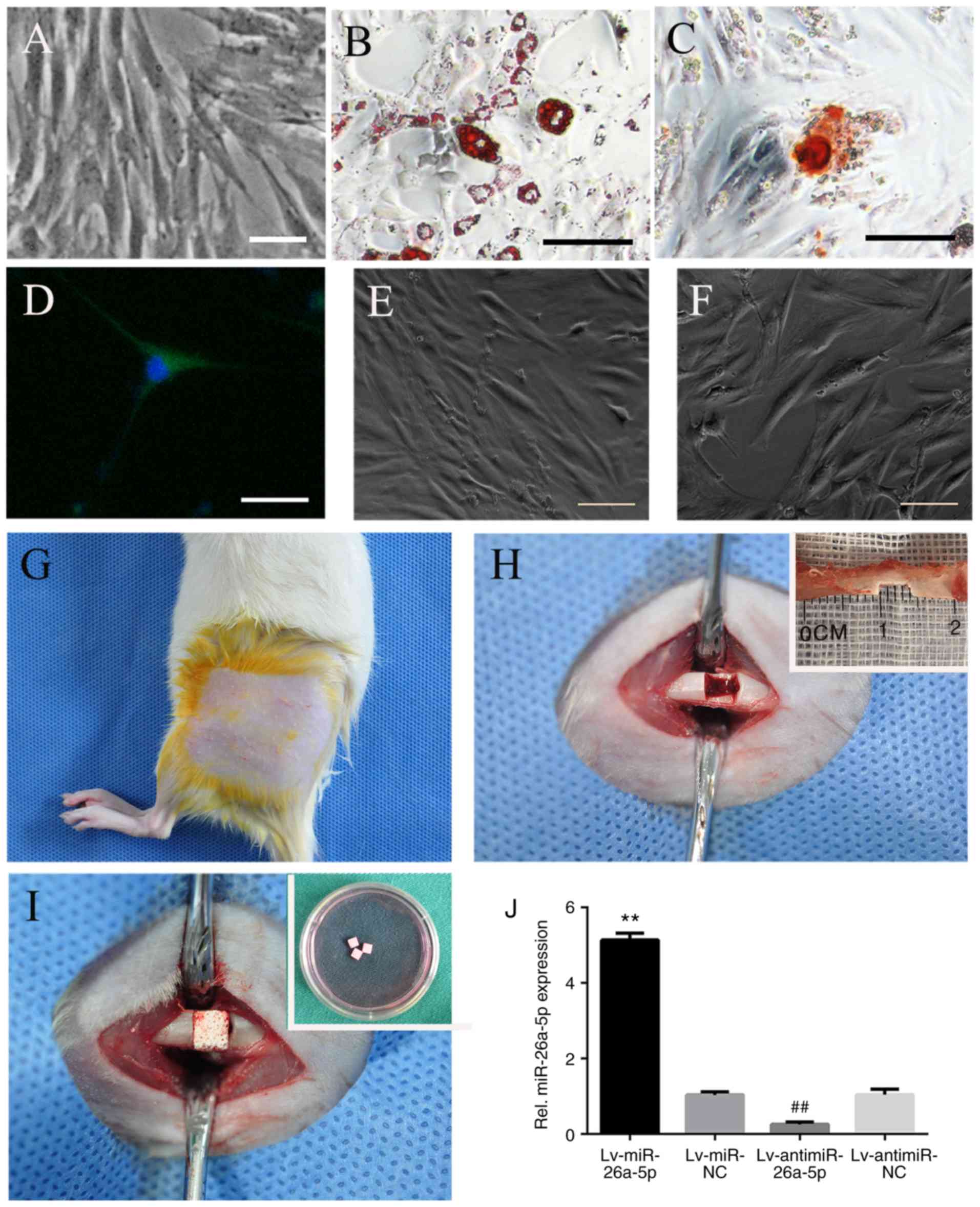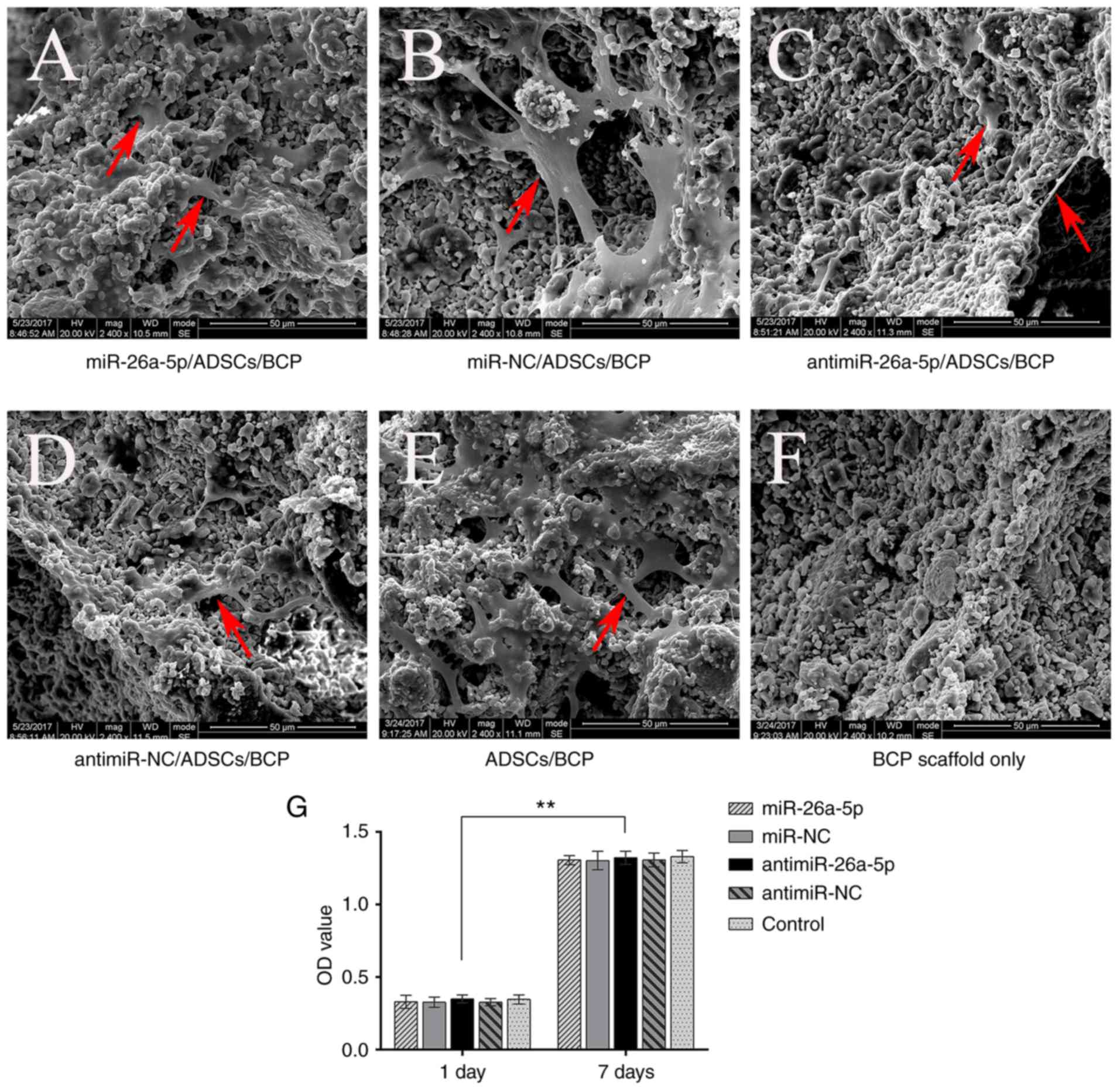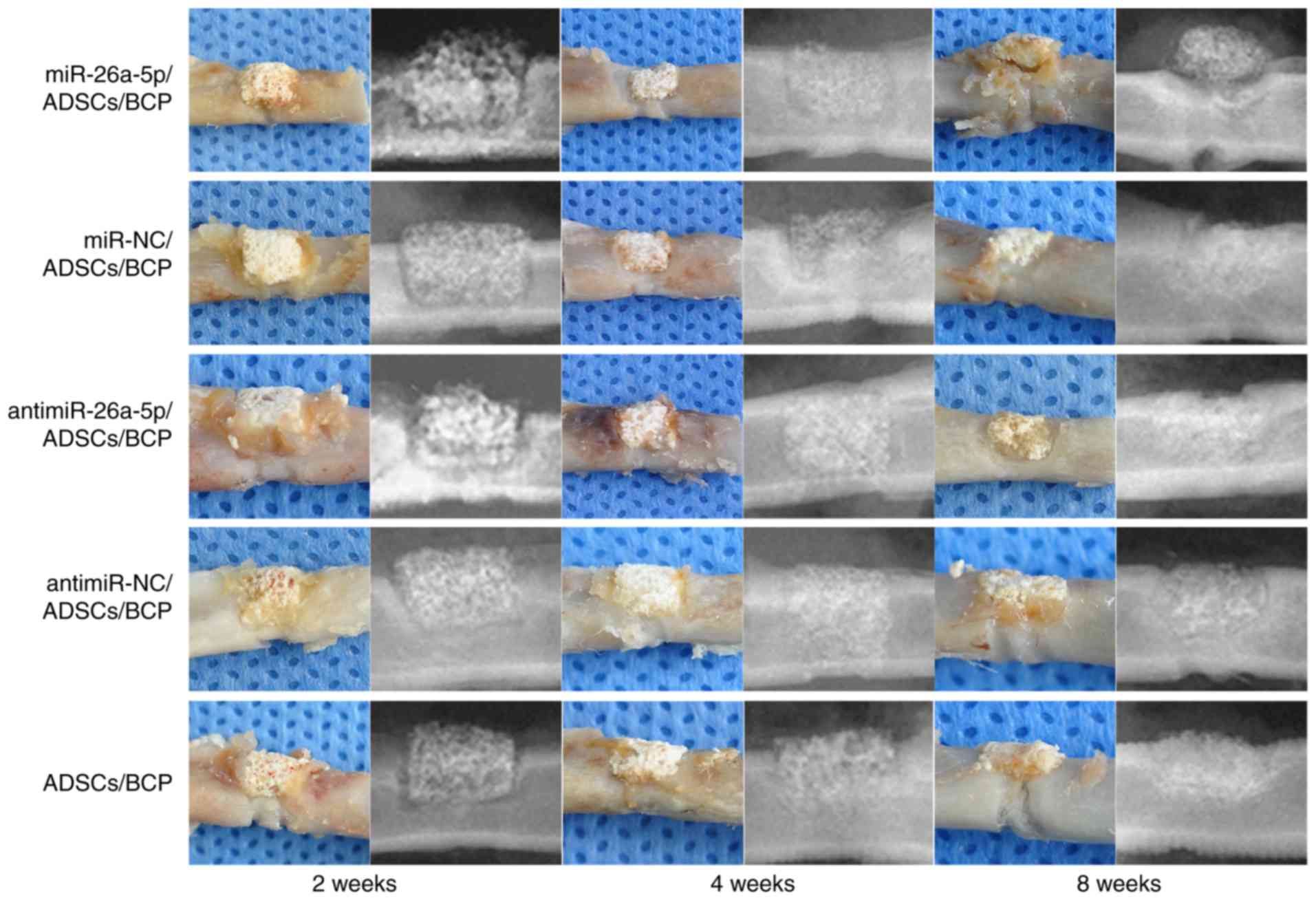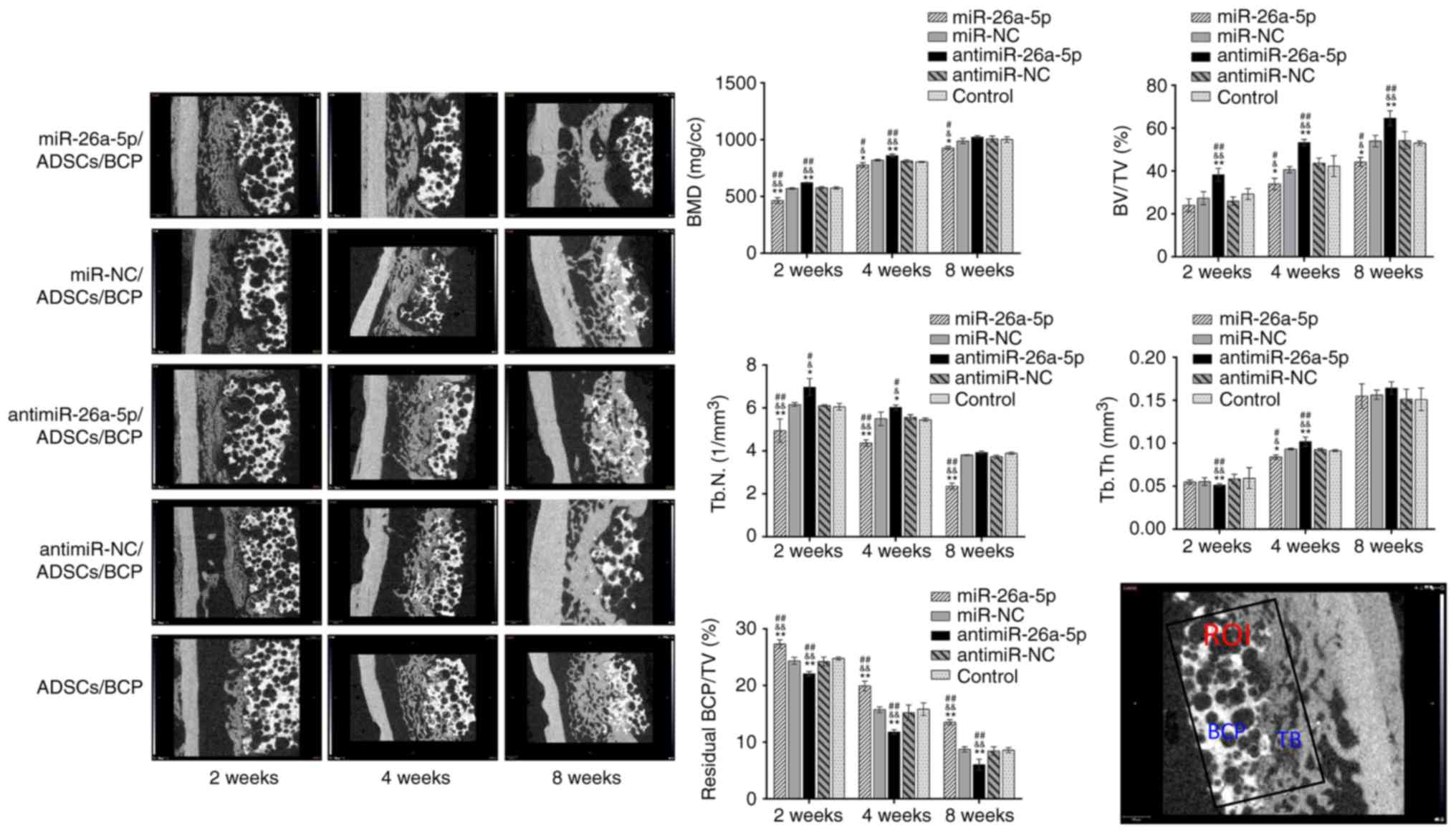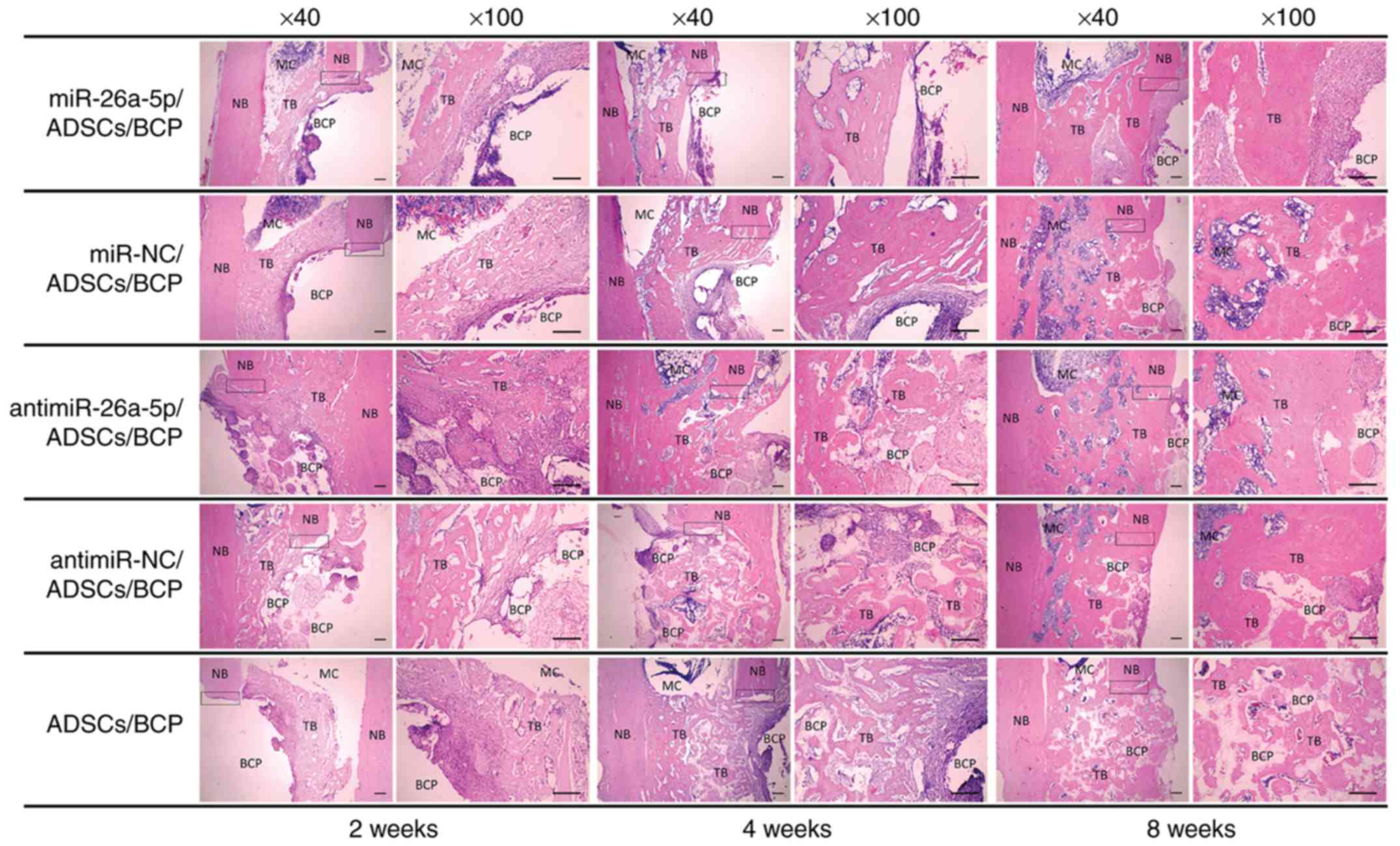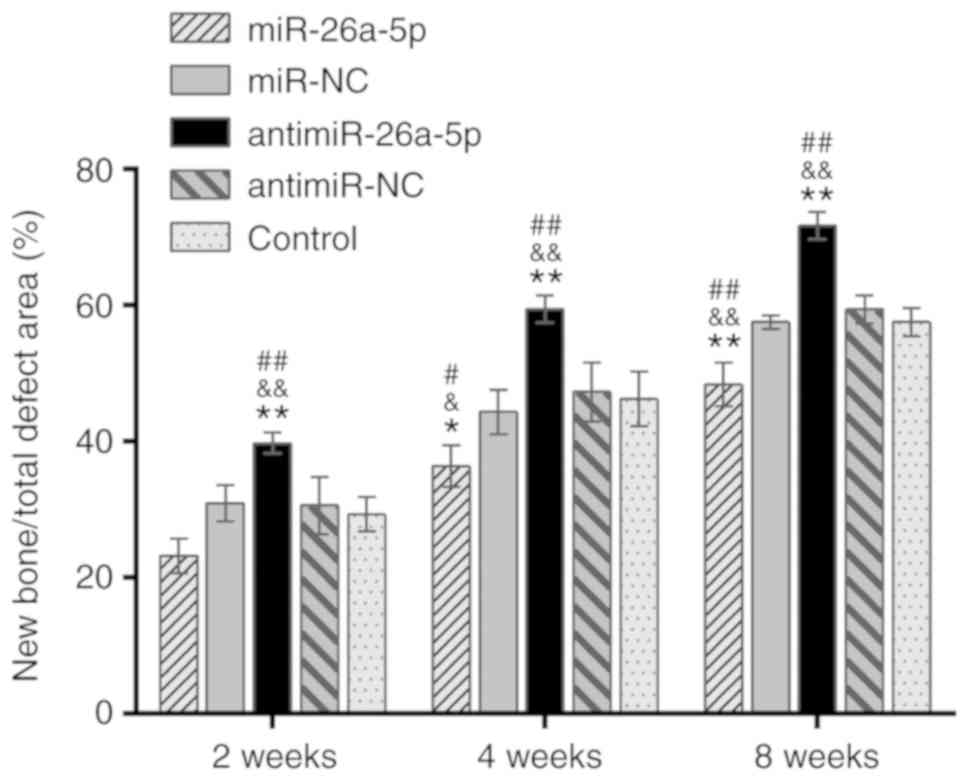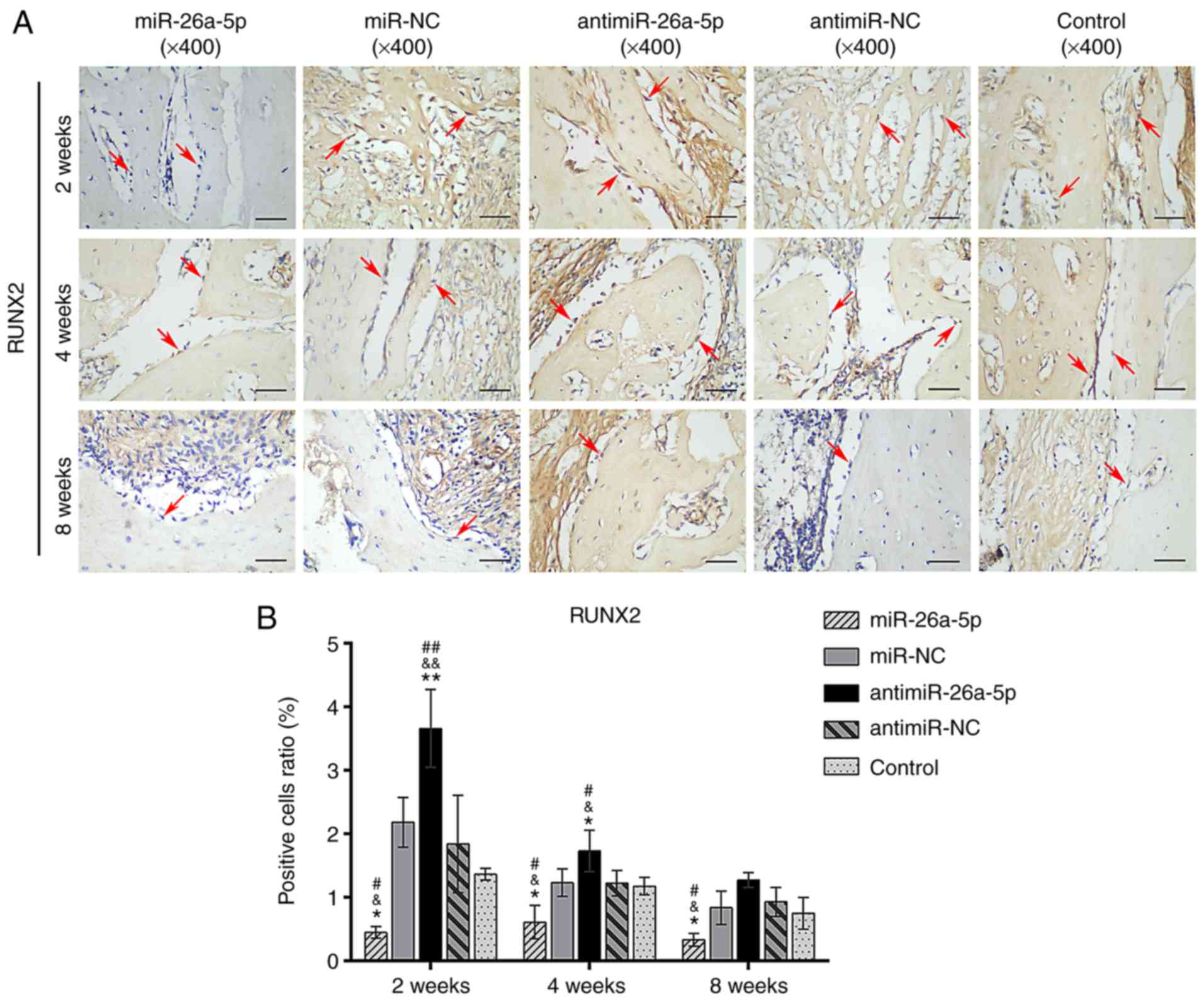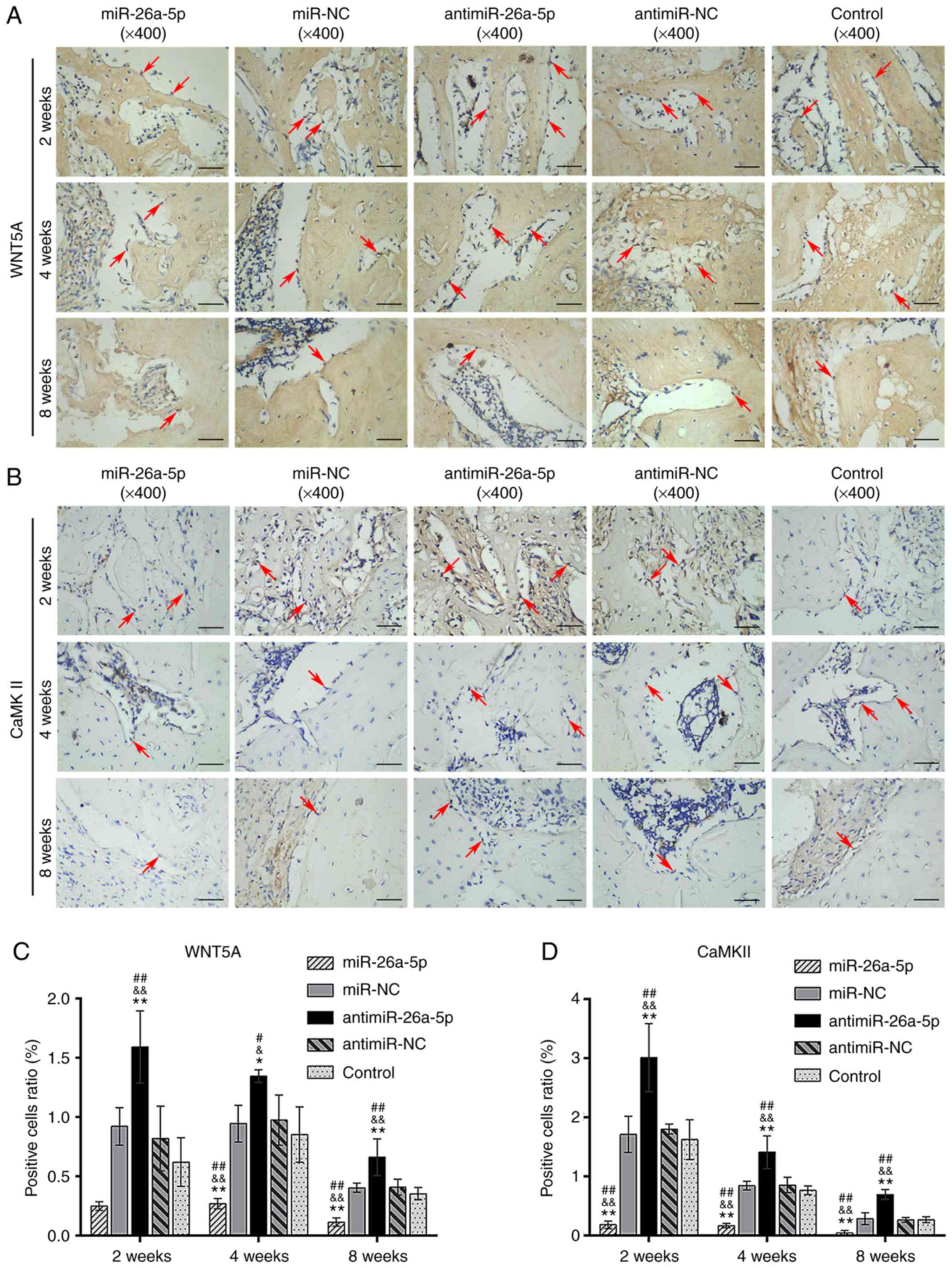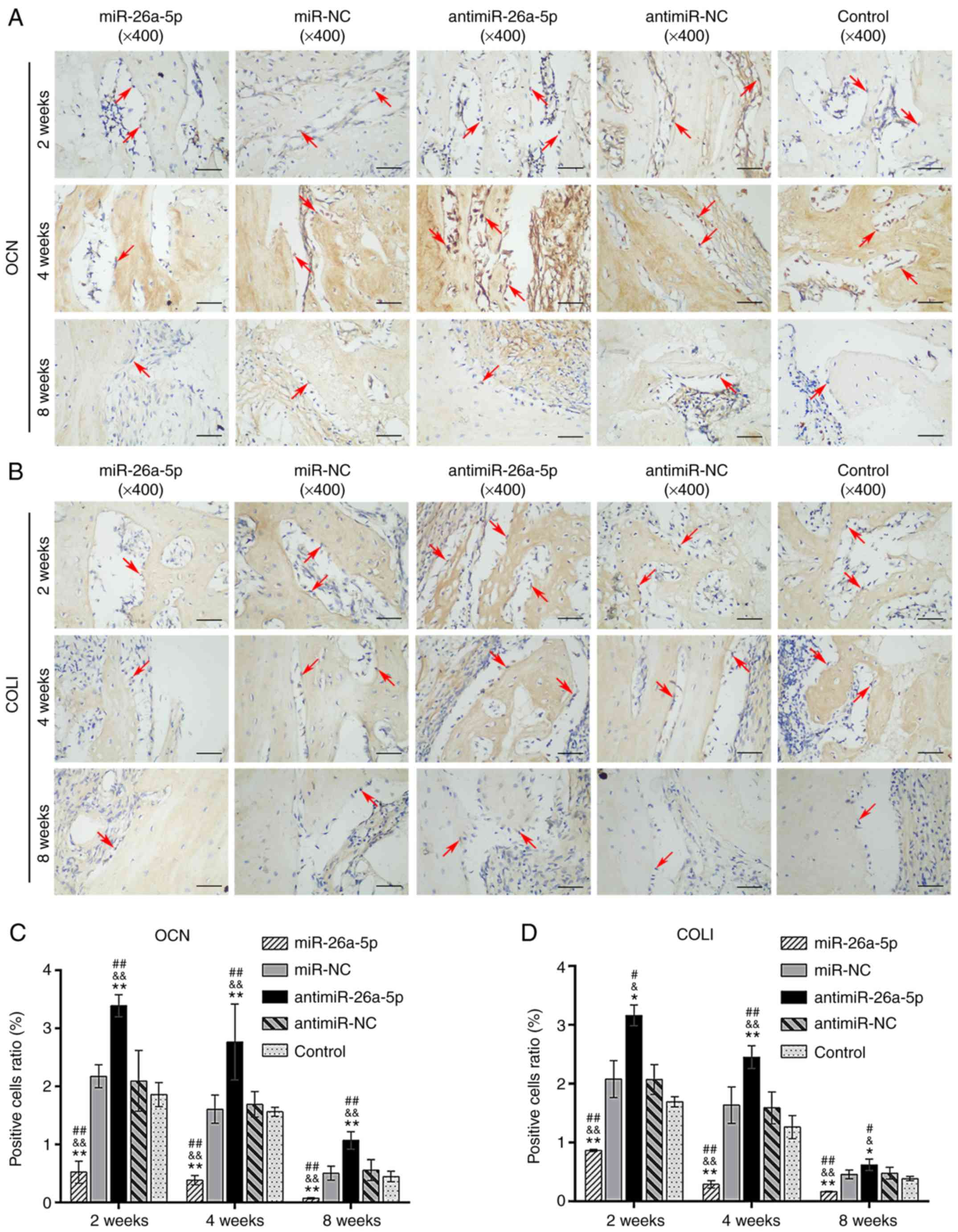The role of antimiR-26a-5p/biphasic calcium phosphate in repairing rat femoral defects
- Authors:
- Published online on: June 20, 2019 https://doi.org/10.3892/ijmm.2019.4249
- Pages: 857-870
-
Copyright: © Yuan et al. This is an open access article distributed under the terms of Creative Commons Attribution License.
Abstract
Introduction
Reconstruction of bone defects, especially massive segmental defects, remains a major challenge. Various approaches have been reported as suitable reconstruction techniques, but all of them are associated with different disadvantages, which limit their wide application (1,2). Although autografts and allografts usually result in satisfactory outcomes, they also have many shortcomings, including, wound infection, bone graft exposure and graft failure (3-5). There has been a recent focus on tissue-engineered bone grafts (TEBGs) as an alternative to autografts for bone repair and reconstruction (6,7). Autografts generally result in satisfactory healing outcomes because of their similar composition to the bone matrix as a scaffold for bone regeneration, as well as the presence of living differentiated and progenitor cells, leading to osteointegration and osteoconduction (8). Notably, the activity of the growth factors present in autografts has been shown to mediate new bone formation through signaling and the recruitment of osteoprogenitor cells (9). The three major components of TEBGs include scaffolds, cells and cell factors that promote osteogenesis (10). TEBGs are constructed based on the composition of autografts. Scaffolds are made of biomaterials, which have the advantages of unlimited supplies, safety, biocompatibility, and bioactivity; they are also capable of inducing the differentiation of stem cells (11). Biphasic calcium phosphates (BCPs), which are a combination of hydroxyapatite (HA) and β-tricalcium phosphate (β-TCP), have been shown to be able to achieve a good outcome in repairing small defects in the clinic (12). However, they cannot be used for load-bearing areas or massive segmental defects, especially critical-size defects, since it is difficult to find an optimal ratio of HA/β-TCP to balance the degradation of the scaffold and the rate of bone formation, which guarantees the stability of the tissue-engineered bone while promoting bone formation (13). Overcoming rapid scaffold degradation therefore involves improving the quantity, quality and rate of new bone formation during the treatment of critically-sized skeletal defects by BCPs.
It was previously reported that the addition of autologic osteoblasts to biomaterials promoted new bone formation, and increased levels of growth factors such as bone morphogenetic protein 2 (BMP-2) (14,15). However, the short-lived in vivo efficacy of BMP-2 and the difficulty of osteoblast isolation limits their usage (16,17). Recent studies have therefore focused on the combination of osteogenic gene-modified mesenchymal stem cells (MSCs) and BCPs for TEBGs, and an important goal is to identify the most effective osteogenic genes in this process (18,19).
Osteoblast differentiation is a fundamental step during bone formation, and is regulated via several signaling pathways including transforming growth factor-β, BMP, and WNT, as well as a number of transcription factors that are regulated by microRNAs (miRNAs/miRs) (20-23). Understanding the signaling pathways and regulators of osteogenesis is critical for also understanding the mechanism underlying bone formation, and for developing novel strategies for bone repair and reconstruction.
miRNAs are endogenous, eukaryotic highly conserved, noncoding RNAs of 19-25 nucleotides in length, which function by complementary pairing to the 3'-untranslated region (UTR) of target mRNAs to inhibit their translation (24). Some miRNAs were recently shown to be able to regulate the osteogenic differentiation of MSCs in vitro; these included miRNA-154-5p, miRNA-30, miRNA-29b, miRNA-133 and miRNA-135 (24-28). However, it is not clear if miRNAs play a role in osteogenesis in vivo. We recently showed that down-regulating endogenous miRNA-26a-5p (antimiR-26a-5p) promoted the osteogenic differentiation of ADSCs (29). These data suggested that antimiR-26a-5p-modified ADSCs combined with BCP scaffolds may accelerate new bone formation and compensate for the rapid degradation of this biomaterial. However, this hypothesis has not been verified.
The present study analyzed the effects of miR-26a-5p on bone formation by transplanting rat femoral defect models with TEBGs constructed usingmiR-26a-5p- and antimiR-26a-5p-modified ADSCs combined with BCP scaffolds. The molecular mechanism of this phenomenon was also investigated by evaluating the expression of key proteins in the Wnt/Ca2+signaling pathway that were implicated in our previous study (29). The aim of the present study was to improve the understanding of the role of miR-26a-5p in bone regeneration, to verify whether the results in vitro obtained by our previous work corresponded with those of the present experiments in vivo, and to potentially provide a new method to optimize the osteogenic ability of BCPs.
Materials and methods
Isolation, culture and identification of ADSCs
A total of 10 four-week-old female Sprague-Dawley (SD) rats (weight, 75 g) obtained from the Sichuan University Animal Experimental Center were used as the source of ADSCs, and all procedures were approved by the Animal Research Committee of Sichuan University. Animals were maintained in the same room under standard conditions including temperature (22-24°C), humidity (55-65%) and light (12-h light/dark cycle) with free access to food and tap water. The ADSCs were harvested from the inguinal fat pads of the rats as previously described (30). Briefly, the excised inguinal fat pads were soaked in PBS with 1% penicillin/streptomycin, and washed 3 times with PBS. They were then minced into small pieces, and digested with 0.2% collagenase type I at 37°C in a shaking incubator for 45 min. After centrifugation at 200 × g for 5 min at room temperature, the cells were resuspended in 3 ml regular growth medium consisting of Minimum Essential Medium α-medium (α-MEM; HyClone; GE Healthcare Life Sciences), 10% fetal bovine serum (Gibco; Thermo Fisher Scientific, Inc.), penicillin (100 U/ml)/streptomycin (100 µg/ml; Sigma-Aldrich; Merck KGaA), and cultured in T25 culture flasks (BD Falcon Labware; BD Biosciences) at 37°C in the presence of 5% CO2. and 95% humidity. The culture medium was renewed every 2 days. Upon reaching 80% confluence, the adherent cells were resuspended with 0.25% trypsin and subcultured. After 2 weeks of culture, the multipotent differentiation of ADSCs (passage 3) was demonstrated based on alizarin red staining, oil red-O staining and βIII-tubulin immunofluorescence staining of transdifferentiated cells as described previously (25,31) (Fig. 1A-D). Cells from passage 3 were used for all subsequent experiments.
Preparation of lentivirus vectors and infection
The construction of the lentiviral vectors containing miR-26a-5p, miR-negative control (NC), antimiR-26a-5p and antimiR-NC as well as the sequences were described in our previous study (29). ADSCs were seeded in 6-well plates (4×105 cells/well) one day before infection. Cells were then incubated overnight with Lv-miR-26a-5p, Lv-miR-NC, Lv-antimiR-26a-5p or Lv-antimiR-NC at final concentrations of 100 nM with Lipofectamine 2000™ (Invitrogen; Thermo Fisher Scientific, Inc.) in Opti-MEM® (Gibco; Thermo Fisher Scientific, Inc.), according to the manufacturer's protocol. At 72 h post-infection, the expression of green fluorescent protein was measured under fluorescence microscopy to evaluate the transfection efficiency. The transfection efficiency was >95% in all groups (Fig. 1E and F). The transfection efficiency of Lv-miR-26a-5p, Lv-miR-NC, Lv-antimiR-26a-5p or Lv-antimiR-NC was verified by reverse transcription-quantitative PCR as described in our previous study (29) (Fig. 1J).
Preparation of BCP scaffolds and cell seeding
All of the BCP scaffolds, shaped into 4×4×2 mm3 squares, were obtained from the National Engineering Research Center for Biomaterials of Sichuan University, and sterilized by γ-irradiation at 25 kGy. The BCP20/80 used in the present study was composed of 20% HA and 80% β-TCP. The porosity was ~74%, and the diameter of the pores was 100-400 µm.
All of the BCP scaffolds were divided randomly and equally into five groups (miR, miR-NC, antimiR, antimiR-NC and Control groups) and were conditioned with α-MEM one day before cell seeding. A total of 9BCP scaffolds from each group were used for cell adhesion evaluation and cell proliferation assays, and the remaining 18 scaffolds from each group were used in the animal experiments. ADSCs infected with Lv-miR-26a-5p, Lv-miR-NC, Lv-antimiR-26a-5p, or Lv-antimiR-NC, and ADSCs (passage 3) were harvested with 0.25% trypsin (at 37°C for 1 min), counted with a hemocytometer, and were loaded onto 5 the corresponding groups of BCP scaffolds (1×105 cells/scaffold). Cells were cultured in regular growth medium overnight for cell adhesion. The miR group consisted of miR-26a-5p-modified ADSCs/BCP; the miR-NC group consisted of ADSCs infected with Lv-miR-NC/BCP (the negative control of the miR group); the antimiR group consisted ofantimiR-26a-5p-modified ADSCs/BCP; the antimiR-NC group consisted of ADSCs infected with Lv-antimiR-NC/BCP (the negative control of the antimiR group); and the Control group consisted of ADSCs/BCP (the empty control).
Evaluation of cell adhesion and proliferation
After 7 days of incubation, 3 cell-scaffold structures from each group were fixed separately in 4% paraformaldehyde solution for 24 hat room temperature, followed by dehydration with an ethanol concentration series of 30-100% and dried in a dryer. One scaffold without cells was cultured and subjected to the same protocol to be used as the blank control. The structures were then sputter coated with gold and subjected to scanning electron microscopy (SEM; FEI Quanta 200 ESEM; Thermo Fisher Scientific, Inc.) to evaluate cell adhesion.
On days 1 and 7 of incubation, a ADSC cell proliferation assay foreach group was performed using Cell Counting Kit-8 (CCK8; Dojindo Molecular Technologies, Inc.). Briefly, CCK-8 solution was added to the medium (CCK-8:medium, 1:10). After incubation for 2 hat 37°C, the supernatant was transferred into a 96 well plate and the absorbance was read at 450 nm with a microplate reader (BioTek Instruments, Inc.).
Animals and surgical procedures
A total of 90 adult female SD rats (300 g; 10-weeks-old) supplied by the Sichuan University Animal Experimental Center were used to establish the femoral defect model in order to study the efficiency of bone regeneration. Animals were maintained under standard conditions including temperature (22-24°C), humidity (55-65%) and light (12-h light/dark cycle) with free access to food and tap water. The surgical procedures and experimental protocols for animal care were approved by the Animal Research Committee of Sichuan University. The SD rats were randomly divided into 5 groups (miR, miR-NC, antimiR, antimiR-NC and Control groups), with 18 rats in each group, corresponding to the 5 groups of cell-scaffold structures (Table I).
Surgery was performed under aseptic conditions. Prior to surgery, the rats were anesthetized with an intraperitoneal injection of 10% chloral hydrate (300 mg/kg), the left thigh was shaved, and the animal received a subcutaneous injection of 2% lidocaine (4 mg/kg) for local anesthesia (Fig. 1G). The left femur was exposed by a lateral longitudinal skin incision and by retracting the quadriceps muscles. The incision was 2.5 cm long in order to expose the medial part of the femoral diaphysis. After the periosteum was stripped off the bone, a 4 mm-long ×2 mm-deep defect was made by a pneumatic fissure bur under sustained saline irrigation (Fig. 1H). Then the cell-scaffold structure was transplanted into the defect (Fig. 1I). Subsequently, the incision was closed by suturing. After surgery, the experimental rat received a penicillin injection (20 U/day) once a day for 3 days and the wound was cleaned every day for a week to prevent infection. If there was any sign of local infection, the anti-infection and wound-cleaning treatment was prolonged.
At 2, 4 or 8 weeks postoperatively, 6 animals from each group were sacrificed randomly by cervical dislocation after anesthesia to obtain left femur samples. Prior to euthanasia, the rats were administered an intraperitoneal injection of 10% chloral hydrate (300 mg/kg) for general anesthesia. Cervical dislocation was then conducted by an experienced researcher very quickly and no rats showed clinical signs of suffering before they died. Only after the lack of a heartbeat had been confirmed and their bodies became cold, were samples obtained according to laboratory standards. In the present study, several signs of suffering were considered to indicate the requirement of humane endpoints such as severe infections, uncontrolled body weight loss or apastia over 36 h and bone fracture.
X-ray analysis
The periosteal tissue was stripped out of the femur diaphysis. Each sample was placed on an occlusal film, then a standardized anteroposterior radiograph of the femur was performed with an X-ray unit (CS 2100; Carestream Dental LLC). The exposure conditions were 70 kV, 8 mA and 0.06 msec.
Micro-computed tomography (CT) analysis
After X-ray films were taken, all of the samples were fixed in 4% paraformaldehyde at room temperature. After 24 h, the samples were dissected to keep the regenerated bone and 4 mm of the native bone bilaterally beneath the defect, and then samples were placed in mid-sized sample tubes with 4% paraformaldehyde. The scans were performed in an axial direction parallel to the long axis of the samples with a micro-CT machine (µCT-50; SCANCO Medical) with medium-resolution (500 projections/180°) and a voxel size of 10 µm. The system was set to 70 kV, 114 mA, and 400 msec integration time. The sagittal images of each sample were captured and regions of interest (ROIs) were outlined as regenerated bones, including 300 slices. The threshold of each image was set as 220-520 to isolate new bone from residual BCP. Within the ROI, the micro-architecture parameters of the new bone were evaluated, including the ratio of bone volume to total volume (BV/TV), bone mineral density (BMD), trabecular number (Tb.N) and trabecular thickness (Tb. Th) using the recommended software (NRecon 1.6 and CTAn 1.8; Bruker Corporation). The ratio of the residual BCP volume to the TV of the ROI was also evaluated using the software.
Histological analysis
All samples were fixed in 4% paraformaldehyde for 72 hat room temperature, decalcified in 20% ethylenediaminetetraacetic acid (EDTA) for 8 weeks, and then dehydrated with a concentration series of alcohol. Samples were embedded in paraffin and sectioned along the longitudinal axis of the samples into 5 µm thick slices. Two sections of each sample were stained with hematoxylin and eosin (H&E) at room temperature for 11 min. DP2-BSW version 2.1 software (Olympus Corporation) coupled with a light microscope were used to capture the images of each section. The relative volume of newly formed bone in the defect area was measured with ImageJ 1.49p software (National Institute of Health).
Immunohistochemical (IHC) analysis
IHC staining was performed to detect the expression of osteocalcin (OCN), collagen I (COLI), Runt-related transcription factor 2 (RUNX2), Wnt family member 5A (WNT5A) and calmodulin-dependent protein kinase II (CaMKII) proteins in the same 5 µm-thick sections used for H&E staining. The sections were firstly deparaffinized, and then incubated with 3% hydrogen peroxide and distilled water at room temperature for 10-20 min to eliminate endogenous peroxidase. Samples were washed three times with double-distilled water, treated with 10 mM sodium citrate (pH 6.0) at a high pressure (room temperature) for 3 min for antigen retrieval and then washed with 0.01 M PBS (pH 7.4) after allowing to naturally cool. Antigen blocking was conducted via the dropwise addition of 5-10% normal goat serum (ZSGB-BIO; OriGene Technologies, Inc.) to the sections at 37°C for 10-30 min. The serum was then removed, and samples were incubated overnight at 4°C with the appropriate dilutions of primary antibodies specific to the following biomarkers: OCN (cat. no. ab13418; 1:400; Abcam), COLI (cat. no. ab34710; 1:200; Abcam), RUNX2 (cat. no. ab76956; 1:200; Abcam), WNT5A (cat. no. Gxp536895-50 ug; 1:200; GenXspan) and CaMKII (cat. no. Gxp63948-50 ug; 1:200; GenXspan). The sections were then washed three times with PBS, and biotinylated goat anti-rabbit secondary antibodies (cat. no. sp9001; 1:400; ZSGB-BIO; OriGene Technologies, Inc.) were added dropwise on COLI, WNT5A and CaMKII sections, and incubated for 10-30 min, while biotinylated goat anti-rat secondary antibodies (cat. no. sp9002; 1:400; ZSGB-BIO; OriGene Technologies, Inc.) were added dropwise on OCN and RUNX2 sections and incubated for 10-30 min, all at room temperature. Samples were washed, and incubated with streptavidin-horseradish peroxidase conjugate followed by 3,3'-diaminobenzidine treatment. Finally, the nuclei were counterstained with hematoxylin at room temperature for 1 min before the sections were dehydrated and placed on cover-slips. The sections for blank control were incubated with PBS instead of primary antibody. DP2-BSW version 2.1 Software (Olympus Corporation) coupled with a light microscope were used to capture the images of regenerated bone in each section (magnification, ×400). Osteoblasts positive for OCN, COLI, RUNX2, WNT5A and CaMKII expression were stained yellow or brown and assessed by ImageJ 1.49p software (National Institutes of Health). The mean area of positive cells was measured and used as the evaluation index.
Statistical analysis
All experiments were performed at least three times. Data were expressed as the mean ± standard derivation. The data obtained were analyzed using SPSS 20.0 (IBM Corp.). All comparisons were performed using Student's two-tailed t-test or a one-way ANOVA. The Student-Newman-Keuls-q test was used as the post hoc test for multiple comparisons. Statistical values were illustrated using GraphPad Prism, version 6.05 (GraphPad Software, Inc.). P<0.05 was considered to indicate a statistically significant difference.
Results
SEM evaluation of cell adhesion and CCK-8 assay evaluation of cell proliferation
The SEM images revealed that the ADSCs successfully and tightly adhered to the BCP scaffolds. There was an adequate number of cells on each of the scaffolds in all five groups (Fig. 2A-F). The ADSCs on the scaffolds had a fusiform or polygon morphology.
The proliferation of ADSCs on the BCP scaffolds of each group was confirmed by CCK-8 assay. Following 7 days of incubation, the number of ADSCs on the BCP scaffolds was significantly increased compared with 1 day of incubation (P<0.01); however, no statistically significant differences between the five groups at the same time point were identified (Fig. 2G).
Gross observation and radiographical analysis of bone regeneration
All experimental animals were healthy and successfully completed the experiment. No rats presented any signs of peritonitis following the administration of 10% chloral hydrate during the study. The maximum percentage of body weight loss observed in this study was ~8%.
At 2,4 and 8 weeks postoperatively, 6 animals from each group were chosen randomly and sacrificed by euthanasia. Left femur samples were harvested for gross observation and X-ray testing (Fig. 3). All 90 experimental samples were obtained from 90 different rats (30 rats were sacrificed at each time point; n=6 rats from each group per time point). The BCP scaffolds were stably connected to the native bones, and there was some connective tissue surrounding the scaffolds. Radiographical analysis revealed that although the lines between BCP and native bones could be clearly identified at 2 weeks postoperatively, they became indistinct at 4 weeks postoperatively as the BCP was beginning to be absorbed. At 8 weeks postoperatively, there was evident new bone formation in the defects, with the BCP scaffolds becoming smaller when compared with at 4 weeks. From the radiographical analyses, the boundaries between BCP and native bones were shown to disappear and the BCP scaffolds were greatly diminished and fused with the regenerative bones except the miR group. The residual BCP did not connect tightly with the newly formed bone in the miR group.
Micro-CT analysis of bone regeneration
At 2,4 and 8 weeks postoperatively, new bone formation in the ROI was measured by micro-CT (Fig. 4). Regenerated bone in the defect increased over time in all 5 groups, starting from surrounding the BCP scaffolds, gradually filling the macro-pores of the BCPs, and finally replacing the BCPs. At 2 weeks postoperatively, there was a significant difference in bone formation between the 5 groups, including in BV/TV, BMD and Tb.N values, which were the highest in antimiR group, and lowest in the miR group (P<0.05); this difference between the groups was retained at 4 and 8 weeks postoperatively (P<0.05). These data suggested that the antimiR group had the most newly formed bone and the highest mineralization rate, while the miR group had the opposite outcome. There was a time-dependent increase in BV/TV, BMD and Tb.Th, and a time-dependent decrease in Tb.N (P<0.05). For Tb.Th, at 2 weeks the antimiR group was the lowest (P<0.01), however, at 4 weeks the antimiR group was the highest (P<0.01) and the miR group was the lowest (P<0.05) among the five groups; no significant differences were found at 8 weeks postoperatively.
Evaluation of the relative quantity of residual BCP scaffolds in the ROI showed a gradual resorption of BCPs with time. At each time point, the antimiR group had the lowest amount of residual BCP, while the miR group had the most (P<0.01), which was the opposite to the results observed for newly formed bone.
Histological evaluation of bone regeneration
Representative sections of the 5 groups (n>3) were captured using software coupled with a light microscope. The red color indicates bone and collagen fibers, and the BCPs formed blanks filling the entire defect area (Fig. 5). At 2 weeks postoperatively, there was a thin layer of newly formed bone and collagen fibers between the BCPs and the adjacent native bones and medullar cavities. Additionally, there was a large amount of spot-like collagen fibers, and even new bone in the center, invading into the macro-pores of the BCPs in the antimiR group. Due to the shape of the pores in the BCP scaffolds, the newly formed tissue in the pores manifested as round spots and the blank spaces surrounding them were occupied by residual BCP. There was no significant tissue formation in the pores of the scaffolds in the other 4 groups. At 4 weeks postoperatively, regenerated trabecular bone grew thicker and more abundant compared with at 2 weeks, and had begun mineralization. The macro-pores of the BCPs began to be filled with newly formed bone and collagen fibers in all groups except the miR group. In the antimiR group, the majority of the BCP pores had been filled by woven bones or collagen fibers. BCP degradation could be identified based on the decrease in blank spaces filling the defects. At 8 weeks postoperatively, with the absorption of scaffolds, the spot-like newly formed bone began to merge together in all groups. The defects were already filled with newly formed woven bones, some of which had become mature lamellar bones, and the rebuilding process was performed with the medullary cavity starting to form in the defect area of the miR-NC, antimiR and antimiR-NC groups. The newly formed bones in the miR group did not completely repair the defect without significant medullary cavity formation. In addition, reticulation structures from the H&E sections could be easily identified in the blank area, namely in the residual BCP scaffolds. This was especially true for the antimiR group at both 4 and 8 postoperative weeks, where reticulation structures could be easily identified in the blank area, namely in the residual BCP scaffolds.
Semi-quantitative analysis of the newly formed bone in the defect area corresponded with the results of micro-CT analysis (Fig. 6). Comparison of the five groups revealed that at each time point, the quantity of new bone was the greatest in the antimiR group (P<0.01) and the lowest in the miR group (P<0.05).
IHC evaluation of bone regeneration
IHC staining demonstrated that osteoblasts from all 5 groups stained positive for 3 osteogenic-related proteins (RUNX2, OCN and COLI) and two pathway proteins (WNT5A and CaMKII) at 2,4 and 8 weeks postoperatively. The histograms revealed that the time courses of expression were similar, with the highest expression at 2 weeks postoperatively, and a decreasing trend over time (Figs. 7-9). The role of miR-26a-5p and antimiR-26a-5p in new bone regeneration was investigated by comparing the relative expression levels of RUNX2, OCN and COLI in the miR and antimiR groups with those in the other groups. Evaluating the proportion of RUNX2-positive cells at ×400 magnification revealed that the miR group had a significantly lower proportion of RUNX2-postive osteoblasts compared with the miR-NC group (P<0.05), while the antimiR group had a significantly higher number of RUNX2-positive cells compared with the antimiR-NC group (P<0.05; Fig. 7). There was no significant difference between the miR-NC, antimiR-NC and Control groups. The expression of OCN and COLI was similar to that ofRUNX2 (Fig. 8). These data indicated that modified ADSCs seeded onto the BCP scaffolds participated in new bone formation. Furthermore, the expression of WNT5A- and CaMKII-positive cells was increased in the antimiR group and decreased in the miR group at all time points (P<0.05; Fig. 9). Taken together, the results indicated that miR-26a-5p regulated in vivo bone formation by ADSCs by inhibiting WNT5A and CaMKII expression.
Discussion
The primary aim of the present study was to construct a novel and effective TEBG using antimiR-26a-5p-modified ADSCs combined with a BCP scaffold. The cell-material complexes were initially constructed successfully in vitro. BCPs were previously shown to have a good ability for cell attachment and proliferation (32,33), and this was consistent with the SEM and CCK8 assay results of the present study. The SEM results demonstrated that the ADSCs adhered and grew on the BCP scaffolds after 7 days of co-culture, with a fusiform or polygon morphology. The results of the CCK-8 assay indicated that the proliferation of ADSCs on the BCPs of the 5 groups was not different, which meant that the cell vitality was satisfactory in the 5 groups. These cell-scaffold complexes could be implanted to repair bone defects.
The present study investigated the role of miR-26a-5p and antimiR-26a-5p on bone regeneration in a rat femoral defect model. Quantitative analysis of micro-CT showed that the quantity and quality of newly formed bone were the lowest in the miR group and highest in the antimiR group when compared with the miR-NC, antimiR-NC and Control groups based on the BMD, BV/TV and Tb.N data (P<0.05). H&E sections from the 5 groups indicated that the amount of newly generated bone was also the highest in the antimiR group and the lowest in the miR group (P<0.05). In addition, the relative expressions of RUNX2, OCN and COLI proteins were the lowest in the miR group and the highest in the antimiR group compared with the other 3 groups (P<0.05). There were no significant differences in the expression of these proteins between the miR-NC, antimiR-NC and Control groups. Taken together, the results from the gross observations, X-ray and micro-CT evaluations, and H&E and IHC examinations all suggested that miR-26a-5p-modified ADSCs combined with BCP scaffolds attenuated the bone formation process. By contrast, antimiR-26a-5p-modified ADSCs combined with BCP scaffolds promoted the process compared with the unmodified ADSCs. Combined with the results of our previous study (29), the present data suggested that miR-26a-5p functions as a negative regulator of the osteogenic differentiation of ADSCs and osteogenesis, while antimiR-26a-5p effectively promotes osteogenic differentiation and osteogenesis. antimiR-26a-5p-modified ADSCs combined with BCP scaffolds should therefore be able to promote bone regeneration effectively, providing potential for bone repair and reconstruction in the load-bearing area.
Although a number of studies have investigated techniques to promote MSC osteogenic differentiation through miRNA modifications (34-36), the molecular mechanisms underlying osteogenesis are not completely understood. We previously showed that miR-26a-5p inhibited the translation of Wnt5a by directly binding to the 3'-UTR of Wnt5a (29). In the present study, IHC staining was conducted to analyze the expression of WNT5A in osteoblasts. The results showed that the ratio of WNT5a-positive cells to negative cells was the lowest in the miR group and the highest in the antimiR group compared with the other groups (P<0.05), suggesting that miR-26a-5p negatively regulated the expression of WNT5A and antimiR-26a-5p promoted the expression of WNT5A. WNT5A has been identified by many studies as a noncanonical Wnt ligand and activates two noncanonical Wnt pathways, one of which is the Wnt/Ca2+ signaling pathway (37,38). Additionally, our previous study proved that miR-26a-5p inhibits the osteogenic differentiation of ADSCs by downregulating the Wnt5a/Ca2+ signaling pathway (29). Therefore, the present study used IHC staining to demonstrate that the expression of CaMKII in Wnt/Ca2+, a downstream mediator of WNT5A via the Wnt/Ca2+ pathway (29), exhibited a similar pattern to WNT5A. Taken together, the results indicated that miR-26a-5p inhibited the expression of WNT5A, leading to low expression of CaMKII, finally resulting in attenuation of bone regeneration. The present study demonstrated that the Wnt/Ca2+signaling pathway regulated osteogenesis by miR-26a-5p, and these results were consistent with the conclusions from our previous study (29).
The ideal properties for scaffolds of tissue-engineering bone include optimal biocompatibility, biodegradability, osteoconduction, osteoinduction, plasticity, mechanical strength, and the ability to be easily sterilized and preserved (11,39). BCPs are composed of calcium phosphate, the same inorganic material which comprises the natural skeleton (12,13,15). The present study suggested that tissue-engineered bone constructed with BCP scaffolds could successfully repair the bone defect, and BCP could be absorbed in vivo (40,41). These results validated earlier studies that reported that BCP is the ideal choice of scaffolds for tissue-engineered bone (12,13,15). HA, with a calcium to phosphorus ratio (Ca/P) of 1.67, is considered to be the stable phase and is hardly absorbed, which may be an obstacle for its use in bone regeneration (42,43). By contrast, β-TCP, with a Ca/P ratio of 1.5, was easily absorbed (43). BCPs are combinations of HA and β-TCP, and have the advantages of both; the combinations compensate for the individual disadvantages of each material (44,45). The biological properties of BCPs, including the biocompatibility, bioactivity, biodegradation, osteoconduction, osteoinduction and cell adhesion are influenced by the physicochemical properties, the most important of which is the HA/β-TCP ratio (39,46,47). Porous BCPs with a lower HA/β-TCP ratio have been shown to have better degradation and osteoinduction, which correlates with better osteogenesis (48). By contrast, a high ratio of β-TCP was shown to correlate with poor mechanical strength and a rapid degradation rate, leading to cracks between BCPs and the newly formed bone, and failure to regenerate bone (49). Previous results revealed that a porous BCP with a HA/β-TCP ratio of 20/80 had good biocompatibility, bioactivity and a fast degradation rate (18,19). The micro-CT and histological analysis in the present study showed that the residual BCP particles were packed by newly formed bone without cracks in the antimiR group, indicating that the rate of bone formation could compensate for the rate of BCP degradation. In the miR group, however, the residual BCP scaffold was repelled, resulting in no support for further bone formation to fill the defect. These results suggested that an increased bone formation rate may lead to successful bone reconstruction with BCP scaffolds, covering the shortages of BCP20/80.
Additionally, micro-CT was used to evaluate the degradation rates of BCP scaffolds in the 5 groups. The present results revealed an accelerated degradation rate in the antimiR group, and decelerated the degradation rate in the miR group compared with the miR-NC, antimiR-NC and Control groups. Simultaneously, the antimiR group exhibited the fastest bone formation rate while the miR group had the slowest bone formation rate. These data suggested that the differences in BCP degradation rates may be related to the application of miR-26a-5p and antimiR-26a-5p. It was previously reported that the microenvironment of bone formation and extracellular matrix facilitated osteoclast adhesion, which is important for material degradation (50). In addition, osteoblasts provide a microenvironment for osteoclastogenesis, and WNT5A secreted by osteoblasts is a new co-stimulatory cytokine for osteoclastogenesis; furthermore, receptor tyrosine kinase-like orphan receptor 2 acts as the functional receptor of Wnt5a in osteoclast precursors (51). Therefore, increased expression of osteoblasts and WNT5A in the antimiR group activated the function of osteoclasts and accelerated the degradation of BCP, a process which requires further investigation.
There were 3 key osteogenic-related proteins that had similar expression profiles among the 5 groups during the time course of the present study. Since OCN, COLI and RUNX2 are markers of osteoblasts and are mainly secreted by them, the ratio of positive cells represents the quantity of osteoblasts and their viability, which further indicates better osteogenesis in vivo. Combined with the results of H&E and micro-CT, IHC analysis may prove the regulatory function of miR-26a-5p in bone formation at the molecular level. The expression of RUNX2, OCN and COLI reached a peak at 2 postoperative weeks, and had slowly declined by 4 postoperative weeks; they reached very low levels at 8 postoperative weeks. A previous study reported the same expression pattern of OCN and RUNX2 as the present study, and that OCN and RUNX2 reached a peak at an early stage (52). However, OCN and COLI are considered to be the late-stage osteogenic markers (53-55). Since the present data indicated that miR-26a-5p and antimiR-26a-5p had the opposite effects on osteogenesis in the miR and antimiR groups, we hypothesized that the early-stage high expression of OCN and COLI may be associated with the calcium and phosphate ions released into the microenvironment by the BCP scaffolds. Previous studies have reported that, with a degradation rate determined by the composition of BCPs, suitable concentrations of ions are released into the microenvironment of tissue-engineered bone, triggering an early and high expression of osteogenic-related genes and proteins through the BMP signaling pathway (56). Elevated Ca2+ concentrations were also shown to promote the recruitment of bone marrow progenitor cells in vivo, regulate the expression of bone morphogenetic protein and COLI in osteoblasts, and modulate the osteoinduction of MSCs (57,58). It is therefore possible that the rapid degradation of BCP20/80 may lead to increased extracellular Ca2+ concentrations, resulting in the early-stage elevated expression of OCN and COLI in osteoblasts. Further investigations are necessary to examine the concentration of ions in the extracellular matrix to verify this hypothesis.
In conclusion, the results of the present study revealed that miR-26a-5p was a negative regulator of osteogenic differentiation of ADSCs. miR-26a-5p-modified ADSCs combined with BCP scaffolds significantly attenuated bone regeneration, while antimiR-26a-5p-modified ADSCs enhanced bone formation. Based on the variation in the expression of WNT5A and its downstream protein, CaMKII, as well as that of osteogenesis-related proteins, it is likely that miR-26a-5p regulated the osteogenic differentiation of ADSCs and bone formation via the Wnt/Ca2+ signaling pathway. The present results indicated a potential regulatory role for miR-26a-5p in bone regeneration. It was also suggested that the combination of antimiR-26a-5p-modified ADSCs and the BCP scaffold could provide a promising and effective strategy for bone repair and reconstruction. The present results provide important preclinical data to support the application of miR-26a-5p in bone-related diseases.
Funding
The present study was supported by grants from the National Nature Science Foundation of China (grant nos. 31570950, 10502037 and 31070833) and the Science and Technology Foundation of Sichuan Province (grant. nos. 2017SZ0032, 2010GZ0225, 2011GZ0335 and 2009SZ0139).
Availability of data and materials
All data generated or analyzed during this study are included in this published article.
Authors' contributions
XY conceived and designed the study, collected, analyzed and interpreted the data, and wrote the manuscript. LH conceived and designed the study, and collection and presented the data. HL analyzed and interpreted the data, and wrote the manuscript. ZG analyzed and interpreted the data. YH conceived and designed the study, and collected the data. SL performed the statistical analysis. TL was involved in the animal experiments. WTa was involved in cell culture and gene transfection. WTi conceived and designed the study. JL conceived and designed the study, wrote the manuscript, and gave final approval of the manuscript.
Ethics approval and consent to participate
All experimental procedures involving animals were approved by the Animal Research Committee of Sichuan University.
Patient consent for publication
Not applicable.
Competing interests
The authors declare that they have no competing interests.
Acknowledgments
Not applicable.
References
|
Lee JE, Kim MB, Han DH, Pyo SH and Lee YH: One-barrel microsurgical fibula flap for reconstruction of large defects of the femur. Ann Plast Surg. 80:373–378. 2018. View Article : Google Scholar : PubMed/NCBI | |
|
Mohseni M, Jahandideh A, Abedi G, Akbarzadeh A and Hesaraki S: Assessment of tricalcium phosphate/collagen (TCP/collagene) nanocomposite scaffold compared with hydroxyapatite (HA) on healing of segmental femur bone defect in rabbits. Artif Cells Nanomed Biotechnol. 46:242–249. 2018. View Article : Google Scholar | |
|
Sakkas A, Schramm A, Winter K and Wilde F: Risk factors for post-operative complications after procedures for autologous bone augmentation from different donor sites. J Craniomaxillofac Surg. 46:312–322. 2018. View Article : Google Scholar | |
|
Burk T, Del Valle J, Finn RA and Phillips C: Maximum quantity of bone available for harvest from the anterior iliac crest, posterior iliac crest, and proximal tibia using a standardized surgical approach: A cadaveric study. J Oral Maxillofac Surg. 74:2532–2548. 2016. View Article : Google Scholar : PubMed/NCBI | |
|
Aponte-Tinao LA, Albergo JI, Ayerza MA, Muscolo DL, Ing FM and Farfalli GL: What Are the complications of allograft reconstructions for sarcoma resection in children younger than 10 years at long-term followup? Clin Orthop Relat Res. 476:548–555. 2018. View Article : Google Scholar : PubMed/NCBI | |
|
Khodakaram-Tafti A, Mehrabani D, Shaterzadeh-Yazdi H, Zamiri B and Omidi M: Tissue engineering in maxillary bone defects. World J Plast Surg. 7:3–11. 2018.PubMed/NCBI | |
|
Diomede F, Gugliandolo A, Cardelli P, Merciaro I, Ettorre V, Traini T, Bedini R, Scionti D, Bramanti A, Nanci A, et al: Three-dimensional printed PLA scaffold and human gingival stem cell-derived extracellular vesicles: A new tool for bone defect repair. Stem Cell Res Ther. 9:1042018. View Article : Google Scholar : PubMed/NCBI | |
|
Reichert JC, Saifzadeh S, Wullschleger ME, Epari DR, Schütz MA, Duda GN, Schell H, van Griensven M, Redl H and Hutmacher DW: The challenge of establishing preclinical models for segmental bone defect research. Biomaterials. 30:2149–2163. 2009. View Article : Google Scholar : PubMed/NCBI | |
|
Le BQ, Nurcombe V, Cool SM, van Blitterswijk CA, de Boer J and LaPointe VLS: The components of bone and what they can teach us about regeneration. Materials (Basel). 11. pp. E142017, View Article : Google Scholar | |
|
Horch RE, Beier JP, Kneser U and Arkudas A: Successful human long-term application of in situ bone tissue engineering. J Cell Mol Med. 18:1478–1485. 2014. View Article : Google Scholar : PubMed/NCBI | |
|
Pennesi G, Scaglione S, Giannoni P and Quarto R: Regulatory influence of scaffolds on cell behavior: How cells decode bioma-terials. Curr Pharm Biotechnol. 12:151–159. 2011. View Article : Google Scholar | |
|
Uzeda MJ, de Brito Resende RF, Sartoretto SC, Alves ATNN, Granjeiro JM and Calasans-Maia MD: Randomized clinical trial for the biological evaluation of two nanostructured biphasic calcium phosphate biomaterials as a bone substitute. Clin Implant Dent Relat Res. 19:802–811. 2017. View Article : Google Scholar : PubMed/NCBI | |
|
Yun PY, Kim YK, Jeong KI, Park JC and Choi YJ: Influence of bone morphogenetic protein and proportion of hydroxyapatite on new bone formation in biphasic calcium phosphate graft: Two pilot studies in animal bony defect model. J Craniomaxillofac Surg. 42:1909–1917. 2014. View Article : Google Scholar : PubMed/NCBI | |
|
Wang S, Zhang Z, Zhao J, Zhang X, Sun X, Xia L, Chang Q, Ye D and Jiang X: Vertical alveolar ridge augmentation with beta-tricalcium phosphate and autologous osteoblasts in canine mandible. Biomaterials. 30:2489–2498. 2009. View Article : Google Scholar : PubMed/NCBI | |
|
Shuang Y, Yizhen L, Zhang Y, Fujioka-Kobayashi M, Sculean A and Miron RJ: In vitro characterization of an osteoinductive biphasic calcium phosphate in combination with recombinant BMP2. BMC Oral Health. 17:352016. View Article : Google Scholar : PubMed/NCBI | |
|
Dragonas P, Palin C, Khan S, Gajendrareddy PK and Weiner WD: Complications associated with the use of recombinant human bone morphogenic protein-2 in ridge augmentation: A case report. J Oral Implantol. 43:351–359. 2017. View Article : Google Scholar : PubMed/NCBI | |
|
Uludag H, D'Augusta D, Palmer R, Timony G and Wozney J: Characterization ofrhBMP-2 pharmacokinetics implanted with biomaterial carriers in the rat ectopic model. J Biomed Mater Res. 46:193–202. 1999. View Article : Google Scholar : PubMed/NCBI | |
|
Arinzeh TL, Tran T, Mcalary J and Daculsi G: A comparative study of biphasic calcium phosphate ceramics for human mesenchymal stem-cell-induced bone formation. Biomaterials. 26:3631–3638. 2005. View Article : Google Scholar | |
|
van Esterik FA, Zandieh-Doulabi B, Kleverlaan CJ and Klein-Nulend J: Enhanced Osteogenic and Vasculogenic differentiation potential of human adipose stem cells on biphasic calcium phosphate scaffolds in fibrin gels. Stem Cells Int. 2016:19342702016. View Article : Google Scholar : PubMed/NCBI | |
|
Lian JB, Stein GS, van Wijnen AJ, Stein JL, Hassan MQ, Gaur T and Zhang Y: MicroRNA control of bone formation and homeostasis. Nat Rev Endocrinol. 8:212–227. 2012. View Article : Google Scholar : PubMed/NCBI | |
|
Zuo B, Zhu J, Li J, Wang C, Zhao X, Cai G, Li Z, Peng J, Wang P, Shen C, et al: MicroRNA-103a functions as a mechanosensitive microRNA to inhibit bone formation through targeting Runx2. J Bone Miner Res. 30:330–345. 2015. View Article : Google Scholar | |
|
Hupkes M, Sotoca AM, Hendriks JM, van Zoelen EJ and Dechering KJ: Micro-RNA miR-378 promotes BMP2-induced osteogenic differentiation of mesenchymal progenitor cells. BMC Mol Biol. 15:12014. View Article : Google Scholar | |
|
Wang Q, Cai J, Cai XH and Chen L: MiR-346 regulates osteogenic differentiation of human bone marrow-derived mesenchymal stem cells by targeting the Wnt/β-catenin pathway. PLoS One. 8:pp. e722662013, View Article : Google Scholar | |
|
Bartel DP: MicroRNAs: Target recognition and regulatory functions. Cell. 136:215–233. 2009. View Article : Google Scholar : PubMed/NCBI | |
|
Li JW, Hu C, Han L, Liu L, Jing W, Tang W, Tian WD and Long J: MiR-154-5p regulates osteogenic differentiation of adipose-derived mesenchymal stem cells under tensile stress through the Wnt/PCP pathway by targeting Wnt11. Bone. 78:130–141. 2015. View Article : Google Scholar : PubMed/NCBI | |
|
Wu T, Zhou H, Hong Y, Li J, Jiang X and Huang H: MiR-30 family members negatively regulate osteoblast differentiation. J Biol Chem. 287:7503–7511. 2012. View Article : Google Scholar : PubMed/NCBI | |
|
Li Z, Hassan MQ, Volinia S, van Wijnen AJ, Stein JL, Croce CM, Lian JB and Stein GS: A microRNA signature for a BMP2-induced osteoblast lineage commitment program. Proc Natl Acad Sci USA. 105:13906–13911. 2008. View Article : Google Scholar : PubMed/NCBI | |
|
Suh JS, Lee JY, Choi YS, Chong PC and Park YJ: Peptide-mediated intracellular delivery of miRNA-29b for osteogenic stem cell differentiation. Biomaterials. 34:4347–4359. 2013. View Article : Google Scholar : PubMed/NCBI | |
|
Li S, Hu C, Li J, Liu L, Jing W, Tang W, Tian W and Long J: Effect of miR-26a-5p on the Wnt/Ca(2+) Pathway and Osteogenic differentiation of mouse Adipose-Derived mesenchymal stem cells. Calcif Tissue Int. 99:174–186. 2016. View Article : Google Scholar : PubMed/NCBI | |
|
Choudhery MS, Badowski M, Muise A and Harris DT: Comparison of human mesenchymal stem cells derived from adipose and cord tissue. Cytotherapy. 15:330–343. 2013. View Article : Google Scholar : PubMed/NCBI | |
|
Ansari S, Diniz IM, Chen C, Sarrion P, Tamayol A, Wu BM and Moshaverinia A: Human periodontal ligament- and gingiva-derived mesenchymal stem cells promote nerve regeneration when encapsulated in alginate/hyaluronic acid 3D scaffold. Adv Healthc Mater. Oct 27–2017, Epub ahead of print. PubMed/NCBI | |
|
Chen Y, Wang J, Zhu XD, Tang ZR, Yang X, Tan YF, Fan YJ and Zhang XD: Enhanced effect of β-tricalcium phosphate phase on neovascularizationof porous calcium phosphate ceramics: In vitro and in vivo evidence. Acta Biomater. 11:435–448. 2015. View Article : Google Scholar | |
|
Huang L, Zhou B, Wu H, Zheng L and Zhao JM: Effect of apatite formation of Biphasic calcium phosphate (BCP) on the osteoblastogenesis using simulated body fluid with or without bovine serum albumin. Mater Sci Eng C Mater Biol Appl. 70:955–961. 2017. View Article : Google Scholar | |
|
Meng YB, Li X, Li ZY, Zhao J, Yuan XB, Ren Y, Cui ZD, Liu YD and Yang XJ: MicroRNA-21 promotes osteogenic differentiation of mesenchymal stem cells by the PI3K/β-catenin pathway. J Orthop Res. 33:957–964. 2015. View Article : Google Scholar : PubMed/NCBI | |
|
Liao YH, Chang YH, Sung LY, Li KC, Yeh CL, Yen TC, Hwang SM, Lin KJ and Hu YC: Osteogenic differentiation of adipose-derived stem cells and calvarial defect repair using baculovirus-mediated co-expression of BMP-2 and miR-148b. Biomaterials. 35:4901–4910. 2014. View Article : Google Scholar : PubMed/NCBI | |
|
Huang S, Wang S, Bian C, Yang Z, Zhou H, Zeng Y, Li H, Han Q and Zhao RC: Upregulation of miR-22 promotes osteogenic differentiation and inhibits adipogenic differentiation of human adipose tissue-derived mesenchymal stem cells by repressing HDAC6 protein expression. Stem Cells Dev. 21:2531–2540. 2012. View Article : Google Scholar : PubMed/NCBI | |
|
Wang Y, Li YP, Paulson C, Shao JZ, Zhang X, Wu M and Chen W: Wnt and the Wnt signaling pathway in bone development and disease. Front Biosci (Landmark Ed). 19:379–407. 2014. View Article : Google Scholar | |
|
Martineau X, Abed É, Martel-Pelletier J, Pelletier JP and Lajeunesse D: Alteration of Wnt5a expression and of the non-canonical Wnt/PCP and Wnt/PKC-Ca2+ pathways in human osteoarthritis osteoblasts. PLoS One. 12:pp. e01807112017, View Article : Google Scholar | |
|
Lacroix D, Chateau A, Ginebra MP and Planell JA: Micro-finite element models of bone tissue-engineering scaffolds. Biomaterials. 27:5326–5334. 2006. View Article : Google Scholar : PubMed/NCBI | |
|
Bouler JM, Pilet P, Gauthier O and Verron E: Biphasic calcium phosphate ceramics for bone reconstruction: A reviewof biological response. Acta Biomater. 53:1–12. 2017. View Article : Google Scholar : PubMed/NCBI | |
|
Tang XH, Mao LX, Liu JQ, Yang Z, Zhang W, Shu MJ, Hu NT, Jiang LY and Fang B: Fabrication, characterization and cellular biocompatibility of porous biphasic calcium phosphate bioceramic scaffolds with different pore sizes. Ceram Int. 42:15311–15318. 2016. View Article : Google Scholar | |
|
Wu Y, Xia L, Zhou Y, Ma W, Zhang N, Chang J, Lin KL, Xu YJ and Jiang XQ: Evaluation of osteogenesis and angiogenesis of icariin loaded on micro/nanohybrid structured hydroxyapatite granules as a local drug delivery system forfemoral defect repair. J Mater Chem B. 3:4871–4883. 2015. View Article : Google Scholar | |
|
Ebrahimi M, Botelho MG and Dorozhkin SV: Biphasic calcium phosphates bioceramics (HA/TCP): Concept, physicochemical properties and the impact of standardization of study protocols in biomaterials research. Mater Sci Eng C Mater Biol Appl. 71:1293–1312. 2017. View Article : Google Scholar | |
|
Jensen SS, Bornstein MM, Dard M, Bosshardt DD and Buser D: Comparative study of biphasic calcium phosphates with different HA/TCP ratios in mandibular bone defects. Along-term histo-morphometric study in minipigs. J Biomed Mater Res B Appl Biomater. 90:171–181. 2009. | |
|
Zhu Y, Zhang K, Zhao R, Ye X, Chen X, Xiao Z, Yang X, Zhu X, Zhang K, Fan Y and Zhang X: Bone regeneration with micro/nano hybrid-structured biphasic calcium phosphate bioceramics at segmental bone defect and the induced immunoregulation of MSCs. Biomaterials. 147:133–144. 2017. View Article : Google Scholar : PubMed/NCBI | |
|
Ng AM, Tan KK, Phang MY, Aziyati O, Tan GH, Isa MR, Aminuddin BS, Naseem M, Fauziah O and Ruszymah BH: Differential osteogenic activity of osteoprogenitor cells on HA and TCP/HA scaffold of tissue engineered bone. J Biomed Mater Res A. 85:301–312. 2008. View Article : Google Scholar | |
|
Ebrahimian-Hosseinabadi M, Etemadifar M and Ashrafizadeh F: Effects of nanobiphasic calcium phosphate composite on bioactivity and osteoblast cell behavior in tissue engineering applications. J Med Signals Sens. 6:237–242. 2016.PubMed/NCBI | |
|
Huang J, Ten E, Liu G, Finzen M, Yu W, Lee JS, Saiz E and Tomsia AP: Biocomposites of pHEMA with HA/beta-TCP (60/40) for bone tissue engineering: Swelling, hydrolytic degradation, and in vitro behavior. Polymer (Guildf). 54:1197–1207. 2013. View Article : Google Scholar | |
|
Daculsi G, Bouler JM and LeGeros RZ: Adaptive crystal formation in normal and pathological calcifications in synthetic calcium phosphate and related biomaterials. Int Rev Cytol. 172:129–191. 1997. View Article : Google Scholar : PubMed/NCBI | |
|
Monchau F, Lefevre A, Descamps M, Belquinmyrdycz A, Laffargue P and Hildebrand HF: In vitro studies of human and rat osteoclast activity on hydroxyapatite, beta-tricalcium phosphate, calcium carbonate. Biomol Eng. 19:143–152. 2002. View Article : Google Scholar : PubMed/NCBI | |
|
Maeda K, Kobayashi Y, Udagawa N, Uehara S, Ishihara A, Mizoguchi T, Kikuchi Y, Takada I, Kato S, Kani S, et al: Wnt5a-Ror2 signaling between osteoblast-lineage cells and osteoclast precursors enhances osteoclastogenesis. Nat Med. 18:405–412. 2012. View Article : Google Scholar : PubMed/NCBI | |
|
Zhang X, Li Y, Chen YE, Chen J and Ma PX: Cell-free 3D scaffold with two-stage delivery of miRNA-26a to regenerate critical-sized bone defects. Nat Commun. 7:103762016. View Article : Google Scholar : PubMed/NCBI | |
|
Sun LY, Wu L, Bao CY, Fu CH, Wang XL, Yao JF, Zhang XD and van Blitterswijk CA: Gene expressions of collagen type I, ALP and BMP-4 in osteoinductive BCP implants show similar pattern to that of natural healing bones. Mater Sci Eng C. 29:1829–1834. 2009. View Article : Google Scholar | |
|
Wang J, Chen Y, Zhu X, Yuan T, Tan Y, Fan Y and Zhang X: Effect of phase composition on protein adsorption and osteoinduction of porous calcium phosphate ceramics in mice. J Biomed Mater Res A. 102:4234–4243. 2014.PubMed/NCBI | |
|
Yi T, Jun CM, Kim SJ and Yun JH: Evaluation of in vivo osteogenic potential of bone morphogenetic Protein 2-Overexpressing human periodontal ligament stem cells combined with biphasic calcium phosphate block scaffolds in a Critical-Size bone defect model. Tissue Eng Part A. 22:501–512. 2016. View Article : Google Scholar : PubMed/NCBI | |
|
Viti F, Landini M, Mezzelani A, Petecchia L, Milanesi L and Scaglione S: Osteogenic differentiation of MSC through calcium signaling activation: Transcriptomics and functional analysis. PLoS One. 11:pp. e01481732016, View Article : Google Scholar : PubMed/NCBI | |
|
Tang Z, Tan Y, Ni Y, Wang J, Zhu X, Fan Y, Chen X, Yang X and Zhang X: Comparison of ectopic bone formation process induced by four calcium phosphate ceramics in mice. Mater Sci Eng C Mater Biol Appl. 70:1000–1010. 2017. View Article : Google Scholar | |
|
González-Vázquez A, Planell JA and Engel E: Extracellular calcium and CaSR drive osteoinduction in mesenchymal stromal cells. Acta Biomater. 10:2824–2833. 2014. View Article : Google Scholar : PubMed/NCBI |



